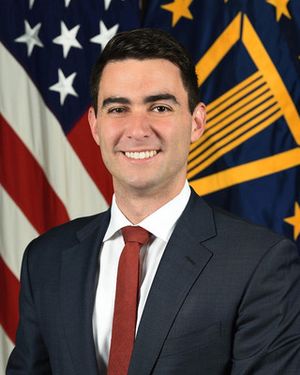Difference between revisions of "Matthew Daniels"
(unstub) |
|||
| (One intermediate revision by the same user not shown) | |||
| Line 1: | Line 1: | ||
{{person | {{person | ||
| − | |wikipedia= | + | |wikipedia=https://en.wikipedia.org/wiki/Matthew_Daniels |
|linkedin=https://www.linkedin.com/in/matthewdaniels | |linkedin=https://www.linkedin.com/in/matthewdaniels | ||
|image=Matthew Daniels.jpg | |image=Matthew Daniels.jpg | ||
|nationality=US | |nationality=US | ||
|interests=Artificial intelligence | |interests=Artificial intelligence | ||
| + | |description= DoD Artificial Intelligence expert. Previously worked for [[Office of Net Assessment]]. | ||
|birth_date= | |birth_date= | ||
|birth_place= | |birth_place= | ||
| Line 12: | Line 13: | ||
|constitutes=politician | |constitutes=politician | ||
}} | }} | ||
| − | '''Dr. Matthew Daniels''' attended the [[Bilderberg]] for the first time in [[Bilderberg/2019|2019]]. | + | '''Dr. Matthew Daniels''' attended the [[Bilderberg]] for the first time in [[Bilderberg/2019|2019]]. He is an expert on [[Machine Learning]] and [[Artificial Intelligence]], and has worked for the [[Office of Net Assessment]]. |
| − | + | ==Education== | |
| + | Daniels received his Ph.D. and M.S. degrees in engineering from [[Stanford]], a B.A. in physics from [[Cornell]], was a fellow at Stanford's [[Center for International Security and Cooperation]]. | ||
| − | + | ==Career== | |
| + | Daniels has worked as a research engineer at [[NASA]], with work in stochastic control, probability theory, and new science missions. | ||
| − | + | He then served as advisor to the [[Office of Net Assessment|director of net assessment]] in the office of the secretary of defense. His work focused on U.S. space programs and artificial intelligence at the whole-enterprise level for DoD. He was also a senior technical advisor in the office of the NASA administrator. Outside of the U.S. government, he has academic affiliations at [[MIT]], [[Stanford]], and [[Georgetown]]. | |
| + | |||
| + | Per 2019, Daniels is the inaugural Technical Director for Machine Learning and [[Artificial Intelligence]] in the Office of the Under Secretary of Defense for Research & Engineering. In this role he oversees and focuses the department's AI/ML research portfolio, architects future capabilities, engages the research and technology organizations of U.S. allies, and advises the undersecretary of defense for research and engineering. | ||
| + | |||
| + | He is a recipient of the Department of Defense Medal for Distinguished Public Service."<ref>https://dod.defense.gov/About/Biographies/Biography-View/Article/1845673/dr-matthew-daniels/</ref><ref>https://www.defense.gov/About/Biographies/Biography/Article/1845673/dr-matthew-daniels/</ref> | ||
{{SMWDocs}} | {{SMWDocs}} | ||
==References== | ==References== | ||
{{reflist}} | {{reflist}} | ||
| − | |||
Latest revision as of 23:43, 20 January 2022
(politician) | |
|---|---|
 | |
| Nationality | US |
| Alma mater | Stanford, Cornell |
| Member of | American Swiss Foundation/Young Leaders/1999 |
| Interests | Artificial intelligence |
DoD Artificial Intelligence expert. Previously worked for Office of Net Assessment. | |
Dr. Matthew Daniels attended the Bilderberg for the first time in 2019. He is an expert on Machine Learning and Artificial Intelligence, and has worked for the Office of Net Assessment.
Education
Daniels received his Ph.D. and M.S. degrees in engineering from Stanford, a B.A. in physics from Cornell, was a fellow at Stanford's Center for International Security and Cooperation.
Career
Daniels has worked as a research engineer at NASA, with work in stochastic control, probability theory, and new science missions.
He then served as advisor to the director of net assessment in the office of the secretary of defense. His work focused on U.S. space programs and artificial intelligence at the whole-enterprise level for DoD. He was also a senior technical advisor in the office of the NASA administrator. Outside of the U.S. government, he has academic affiliations at MIT, Stanford, and Georgetown.
Per 2019, Daniels is the inaugural Technical Director for Machine Learning and Artificial Intelligence in the Office of the Under Secretary of Defense for Research & Engineering. In this role he oversees and focuses the department's AI/ML research portfolio, architects future capabilities, engages the research and technology organizations of U.S. allies, and advises the undersecretary of defense for research and engineering.
He is a recipient of the Department of Defense Medal for Distinguished Public Service."[1][2]
Event Participated in
| Event | Start | End | Location(s) | Description |
|---|---|---|---|---|
| Bilderberg/2019 | 30 May 2019 | 2 June 2019 | Switzerland Montreux | The 67th Bilderberg Meeting |